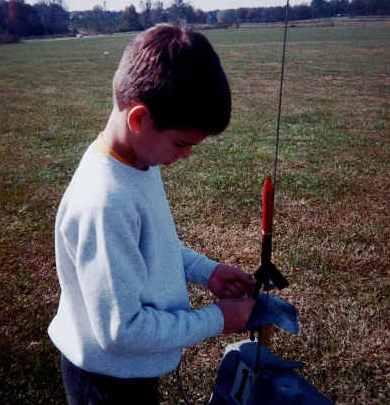| Construction Rating: | starstarstarstarstar_border |
| Flight Rating: | starstarstarstarstar_border |
| Overall Rating: | starstarstarstarstar_border |
| Diameter: | 0.74 inches |
| Length: | 11.00 inches |
| Manufacturer: | Estes  |
| Skill Level: | 1 |
| Style: | Sport |
 Brief:
Brief:
A small, lightweight 3FNC rocket with an unusual nose cone.
Construction:
Actually, I built 2 Yankee kits; one to replace the initial rocket that disappeared after its third flight. The first kit featured a nice balsa nose cone, but the second kit, while otherwise identical, had a plastic nose cone. But both kits featured a paper body tube, die cut balsa fins, a short piece of elastic, a streamer, and a decal. the quality of components was excellent, except for the shock cord, which was comically short on each kit.
The plastic nose cone was a tight fit, and needed considerable sanding before it would fit. The balsa piece fit nicely but had quite a bit of grain to it. I prefer this to plastic, however. At any rate, it is a straightforward build, and the instructions seemed to be somewhat better than normal Estes fare.
Finishing:
The balsa nose needed considerable filling and sanding to be paintable. The plastic piece was ready to go right from the box, once the shoulder was sanded. I chose to use automotive primer on the original, applying thin coats and sanding in between applications to get rid of the spiral and fin grain. Then I applied some black enamel, followed with a coat of clear to keep the decals on. Unfortunately, this one disappeared soon. The second kit was simply sanded and sprayed with red and black and was considered finished after the decals were applied.
Construction Rating: 4 out of 5
Flight:
Launching with an A8-3 produced a good, straight flight. I followed this with 2 flights on a B6-6, and the last one was never seen again. The subsequent kit was flown on "A" motors only for a while, but I couldn't help trying a C6-7. We lost it too, but fortunately someone in our club found it and brought it to the RSO. It has since been modified for 13mm motors, and does well enough on an A10-3T. I've never had a recovery failure, but if it did, the thing is so light weight it would probably recover just fine.
Recovery:
The supplied shock cord is just too small. After about 6 flights some wear can be seen on the end of the body tube because of the shock cord whipping it. A good thing to do would be to double the cord length, at least. Also, the bottom of the fins are getting crisp, though not quite burnt. Overall, though, this is a great flier.
Flight Rating: 4 out of 5
Summary:
Personally, I prefer the older balsa nose cone, but the plastic one will suffice. Either way, it's a great beginner kit that a kid will have no problem constructing, and will deliver many good flights, so long as you can find it again. But add some length to the shock cord!
Overall Rating: 4 out of 5
 |
 |
Flights
 |
 |
unknown (June 24, 2003)
Sponsored Ads
 |
 |












A. (March 1, 2001)